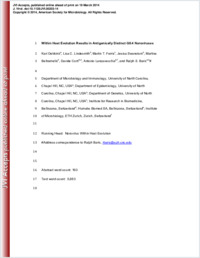Within-host evolution results in antigenically distinct GII.4 noroviruses
- Debbink, Kari Department of Microbiology and Immunology, University of North Carolina, Chapel Hill, North Carolina, USA
- Lindesmith, Lisa C. Department of Epidemiology, University of North Carolina, Chapel Hill, North Carolina, USA
- Ferris, Martin T. Department of Genetics, University of North Carolina, Chapel Hill, North Carolina, USA
- Swanstrom, Jesica Department of Epidemiology, University of North Carolina, Chapel Hill, North Carolina, USA
- Beltramello, Martina Institute for Research in Biomedicine (IRB), Faculty of Biomedical Sciences, Università della Svizzera italiana, Switzerland
- Corti, Davide Institute for Research in Biomedicine (IRB), Faculty of Biomedical Sciences, Università della Svizzera italiana, Switzerland - Humabs Biomed SA, Bellinzona, Switzerland
- Lanzavecchia, Antonio Institute for Research in Biomedicine (IRB), Faculty of Biomedical Sciences, Università della Svizzera italiana, Switzerland - Institute of Microbiology, ETH Zurich, Zurich, Switzerland
- Baric, Ralph S. Department of Microbiology and Immunology, University of North Carolina, Chapel Hill, North Carolina, USA - Department of Epidemiology, University of North Carolina, Chapel Hill, North Carolina, USA
-
03.06.2014
Published in:
- Journal of virology. - 2014, vol. 88, no. 13, p. 7244–7255
English
Genogroup II, genotype 4 (GII.4) noroviruses are known to rapidly evolve, with the emergence of a new primary strain every 2 to 4 years as herd immunity to the previously circulating strain is overcome. Because viral genetic diversity is higher in chronic than in acute infection, chronically infected immunocompromised people have been hypothesized to be a potential source for new epidemic GII.4 strains. However, while some capsid protein residues are under positive selection and undergo patterned changes in sequence variation over time, the relationships between genetic variation and antigenic variation remains unknown. Based on previously published GII.4 strains from a chronically infected individual, we synthetically reconstructed virus- like particles (VLPs) representing early and late isolates from a small-bowel transplant patient chronically infected with norovirus, as well as the parental GII.4-2006b strain. We demonstrate that intrahost GII.4 evolution results in the emergence of antigenically distinct strains over time, comparable to the variation noted between the chronologically predominant GII.4 strains GII.4-2006b and GII.4-2009. Our data suggest that in some individuals the evolution that occurs during a chronic norovirus infection overlaps with changing antigenic epitopes that are associated with successive outbreak strains and may select for isolates that are potentially able to escape herd immunity from earlier isolates.
- Language
-
- English
- Classification
- Medicine
- License
-
License undefined
- Open access status
- green
- Identifiers
-
- RERO DOC 324249
- DOI 10.1128/JVI.00203-14
- ARK ark:/12658/srd1318854
- Persistent URL
- https://n2t.net/ark:/12658/srd1318854
Statistics
Document views: 174
File downloads:
- Texte intégral: 179
